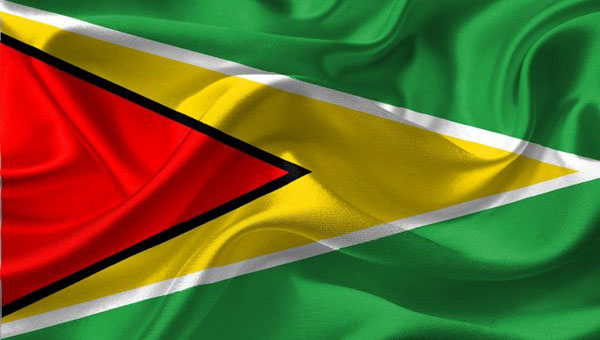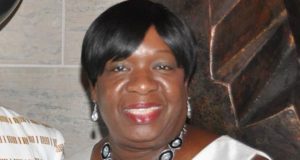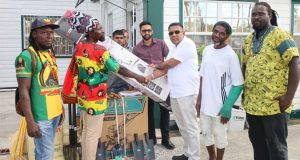By Ivelaw L. Griffith
Guest Contributor
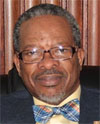 This year electoral winds will blow across eight nations in Latin America and the Caribbean — Belize, Bolivia, the Dominican Republic, Guyana, St. Kitts and Nevis, St. Vincent and the Grenadines, Suriname, and Trinidad and Tobago.
This year electoral winds will blow across eight nations in Latin America and the Caribbean — Belize, Bolivia, the Dominican Republic, Guyana, St. Kitts and Nevis, St. Vincent and the Grenadines, Suriname, and Trinidad and Tobago.
Guyana, the most consequential of the eight countries, saw winds of controversy blow, when the elections were held on March 2. The seriousness of Guyana’s elections relates to the anticipated economic boom, driven by the massive offshore oil find, there. This partly explains the political volcano that erupted after the voting, such that the winner has not yet been declared, more than six weeks after the voting.
The discovery of some eight billion barrels of oil will propel the growth of the economy by a whopping 86 percent this year alone, according to the International Monetary Fund (IMF). Last year’s figure was 4.7 percent.
In 2019, estimates for revenues, over the lifetime of the projects, were US$117 billion. They ballooned to US$168 billion, after the 16th deepwater discovery was announced in January. Guyana is now among the world’s largest crude oil producers.
While ExxonMobil captures the headlines, this is actually a partnership, also involving Hess Corporation and a unit of China’s National Offshore Oil Corporation (CNOOC). Meanwhile, companies from Britain, Canada, France, and Spain also are part of the oil seascape and landscape.
December 20, of last year, marked the historic “First Oil” production, and Guyana’s President, David Granger, declared the day as National Petroleum Day.
 Whoever ultimately is declared the victor will need to ponder some geopolitical realities and make some tough, consequential decisions, let alone need to think beyond one electoral cycle, and in terms of at least 10 to 15 years. At least three sets of factors rise to the level of imperatives — things that need to be actioned. They pertain to what I describe as Geopolitical Neighborhoods: the Proximate Neighborhood; Far Away Neighborhoods; and the Wet Neighborhood.
Whoever ultimately is declared the victor will need to ponder some geopolitical realities and make some tough, consequential decisions, let alone need to think beyond one electoral cycle, and in terms of at least 10 to 15 years. At least three sets of factors rise to the level of imperatives — things that need to be actioned. They pertain to what I describe as Geopolitical Neighborhoods: the Proximate Neighborhood; Far Away Neighborhoods; and the Wet Neighborhood.
Geopolitics itself pertains to the relationship between physical and political geography, on the one hand, and national power on the other. Key factors include the possession of strategic materials; ownership of, or access to, strategic waterways; and the possession, or location of, military bases and other security installations. What geopolitical imperatives, then, might the victors consider?
Imperatives of the Proximate Neighborhood
Brazil, Suriname, and Venezuela are the key countries in Guyana’s Proximate Geopolitical Neighborhood, and Venezuelan dynamics are the most consequential, and immediate, of the three.
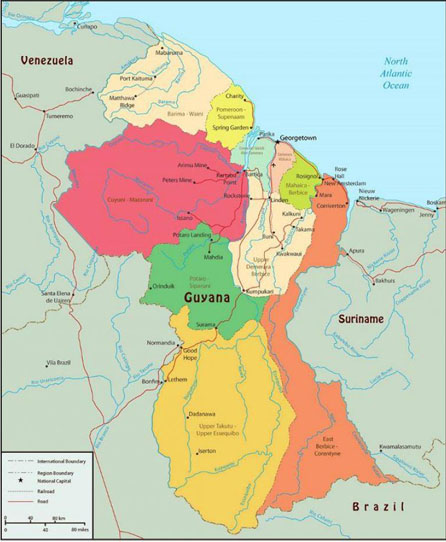 Public hearings, before the International Court of Justice (ICJ) in The Hague, supposed to begin on March 23 — at which Guyana was to present the first round of oral arguments, and Venezuela had opted out of the proceedings — was postponed, indefinitely.
Public hearings, before the International Court of Justice (ICJ) in The Hague, supposed to begin on March 23 — at which Guyana was to present the first round of oral arguments, and Venezuela had opted out of the proceedings — was postponed, indefinitely.
This stage of the resolution efforts, follows the filing, by Guyana, in March 2018, of an application to the Court, seeking to confirm the legal validity and binding effect of the Arbitral Award of October 1899.
Venezuela claims the entire area, west of the Essequibo River, some five-eighths of Guyana’s 214,970 square kilometers, which is an area, rich in oil, gold, diamond, and other minerals, and is part of the country’s Amazon territory. Venezuela’s claim is an existential one, so far as Guyana is concerned, and the outcome of the Court’s ultimate decision will have far-reaching implications for it.
The entire matter is likely to drag on several more years, which means that this issue will command the attention of Guyana’s leaders, for a while more.
The Suriname part of the Neighborhood also has been a sensitive one, with both maritime and territorial disputes, originating in the colonial era and influencing post-independence relations between the two countries.
The contest over the oil- and marine-rich maritime zone was settled in September 2007, by arbitration, under the United Nations Convention of the Law of the Sea (UNCLOS), when the UNCLOS Tribunal declared that Guyana was entitled to two-thirds of the disputed zone and Suriname one-third.
Still in dispute is the timber- and mineral-rich New River Triangle, which involves 15,540 kilometers of territory. The Guyana-Suriname Border Mixed Commission, established in 1989, as a framework for rapprochement and to move the parties progressively towards resolution, has not been as effective as hoped.
One significant development was Suriname’s action in 2009, in presenting to the world, what it long had done internally: cartographically portraying the New River Triangle as part of its territory. Guyana offered feeble protest, but has been unable to secure a retraction of the map.
2020 also is a power contestation year for Suriname, which has elections, carded for May, and has domestic complications of its own. As with Guyana, Suriname also has an oil boon in the offing, with a major offshore discovery, announced on January 7, by Apache Corporation and French-owned Total.
Preoccupation with petroleum pursuits by both countries suggests that the resolution of the New River Triangle dispute will be a low-priority. Instead, emphasis probably will be placed on reenergizing the work of the Mixed Border Commission.
Imperatives Related to Far Away Neighborhoods
Guyana now is a serious magnet for people and businesses. For instance, the first Annual International Petroleum Business Summit and Exhibition (GIPEX) in 2018 attracted some 270 individuals, from the Caribbean, North America, Europe, and Africa. The attendance leaped to 600 delegates last year.
The U.S. embassy in Georgetown reported, this past February 20, that it was handling inquiries from more than 100 U.S. businesses about launching operations in Guyana. American Airlines and Jet Blue began service there, and Delta is contemplating resuming its service.
Guyana also has gold, diamonds, bauxite, manganese, uranium, agriculture, timber, and tourism. To its credit, the Granger government had committed itself to economic diversification, and this is likely to be embraced by whoever leads the new government. So, one can expect these non-oil areas to also attract people from other Neighborhoods.
While on a tour, through the Caribbean, to promote my book, Drugs and Security in the Caribbean, two decades ago, the head of prisons in Aruba shared a remarkable observation with me: “Professor, this international drug-trafficking is providing my prison officers with a great education about world geography; we have, in prison, people from countries that we never knew existed.”
In all likelihood, as Guyana magnetizes, because of the oil and the economic diversification, people will trek there, from places some Guyanese never knew existed. Most trekkers will make lawful ingress. But many — perhaps thousands, depending on economic conditions in Venezuela and elsewhere — will try to enter, illegally. Guyana’s post-elections leaders need to prepare for this.
Authorities will need to boost the nation’s public security capabilities, as crime — especially homicides, burglary, spousal abuse, prostitution, sex trafficking, illegal mining, and drug trafficking and abuse — likely will spike. Cyber-security also should command more attention, as Guyana, probably, will become a cybercrime magnet, in relation to businesses, government entities, and individuals of high worth.
The authorities also must guard against the resurgence of piracy, as people will come, from Far Away Neighborhoods, by sea, and not only with lawful intent. Overall, major investments in the country’s public security is a geopolitical imperative — both to enhance domestic safety and security, and to mitigate against negative pursuits of people from Far Away Neighborhoods.
Imperatives Concerning the Wet Neighborhood
This third area pertains to where Guyana is, geographically, and what it is facing, environmentally. In comparative Caribbean terms, Guyana is a large nation. It is 20 times the size of Jamaica and it could accommodate all the member countries of CARICOM in its territory. However, it is in a Wet Neighborhood.
The name Guyana derives from an indigenous Indian (Amerindian) term, meaning “land of waters”. Called so, for good reason, Guyana has some 965 miles of navigable rivers, of which the Berbice, Demerara, and Essequibo are the largest. The Essequibo — the largest of the three — originates near the border with Brazil and runs 600 miles north, to the Atlantic Ocean, with an estuary that is 20 miles wide.
Guyana also has a 285-mile long Atlantic coastline, with places that are as much as six feet below sea level. The coastal existence is “protected” by a sea wall, construction of which began in 1855. Also part of the “protection” are mangrove forests and rivers and canals that channel the water flow from the country’s interior, through the plains, to the Atlantic Ocean.
A system of kokers (sluices), designed by the Dutch when they controlled that part of now Guyana, is a key part of the protection. At high tide, the kokers are closed to prevent inundation, and at lower tide, they are opened to permit the water flow from the country’s interior, through to the Atlantic Ocean.
Not only does the capital city, Georgetown, lie along the coast, but so does some 80 percent of the country’s population. So, the country has had to cope with flooding. The most devastating episode, in recent times, occurred in January 2005, when the country experienced the highest recorded rainfall since 1888. This resulted in a massive flood that affected about 84 percent of the population, and left an estimated US$ 500 million in damages to the social and productive sectors and to infrastructure.
The Granger government demonstrated its appreciation of the seriousness of the Wet Neighborhood challenge, in undertaking a flood mitigation and environmental beautification project, just after being elected in May 2015. In partnership with private sector companies, it cleared canals and drains in Georgetown and in villages along the coast, as blockage had been a major flood mitigation obstacle over the years. Moreover, with support from the European Union and other partners, it repaired and strengthened the Sea Wall and restored several mangrove areas. However, such efforts will not suffice, given the magnitude of the challenge.
The Wet Neighborhood imperative is an existential one. After studying the volume of water, worldwide, that could come from shrinking glaciers and ice sheets, the Union of Concerned Scientists (USC) projected a sea-level rise of between 2.6 feet and 6.6 feet by 2100. The USC study indicates that “the Guyana coast is subsiding, owing to groundwater extraction, soil compaction, and drainage of wetlands. From 1951 to 1979, sea level, off Guyana, rose at a rate some six times the global average, (0.4 inch, or 10.2 millimeters per year), around 6 times the twentieth century average or 3 times the 1993 to 2009 annual average.”
U.S. economist, Jay Mandle, also cited a sobering 2014 report, by the Caribbean Planning for Adaptation to Global Climate Change Project, which concluded that: “the entire fabric of Guyanese society — population, agriculture, industry, and infrastructure — is vulnerable to even slight increases in sea level rises, rainfall intensities, saltwater intrusion and droughts”. The report also predicted disastrous outcomes.
The Wet Neighborhood realities make it necessary to relocate, at least the capital, away from the coast. Plans to relocate Georgetown have been touted, since the time of President Forbes Burnham in the 1970s. Regrettably, it may take another disaster to propel leadership and citizenry into action in this respect.
The oil wealth that will accrue to the country will provide more than enough funding for what will be a mega-project. And there is no shortage of land. One hopes that the nation’s leaders will act on this capital relocation imperative, before too long.
Conclusion
Notwithstanding the post-election crisis, this is an exciting time for Guyana. Were Charles Dickens, the author of A Tale of Two Cities, writing about contemporary Guyana, he probably would describe the country as facing “the best of times, with even better times to come.”
Guyana’s post-elections leaders will have to manage several geopolitical realities, including imperatives, related to the Proximate Neighborhood, Far Away Neighborhoods, and the Wet Neighborhood.
Ivelaw Lloyd Griffith is a non-resident senior associate in the Americas Program at the Center for Strategic and International Studies and a distinguished visiting scholar at the University of Delaware. A former vice chancellor of the University of Guyana, he’s an expert on Caribbean security, who has testified before the United States Congress on Caribbean security matters. He’s currently finalizing Challenged Sovereignty: The Impact of Drugs, Crime, Terrorism and Cyber Challenges on Security and Sovereignty in the Caribbean for the University of Illinois Press.
This Pride News Online-edited report was reprinted by request of the author, and through the courtesy of the Center for Strategic and International Studies (CSIS), a private, tax- exempt institution focusing on international public policy issues.
It was originally produced, on march 25, by CSIS, which does not take specific policy positions. Accordingly, all views, positions, and conclusions expressed in this publication should be understood to be solely those of the author(s).
© 2020 by the Center for Strategic and International Studies. All rights reserved.
 Pride News Canada's Leader In African Canadian & Caribbean News, Views & Lifestyle
Pride News Canada's Leader In African Canadian & Caribbean News, Views & Lifestyle

